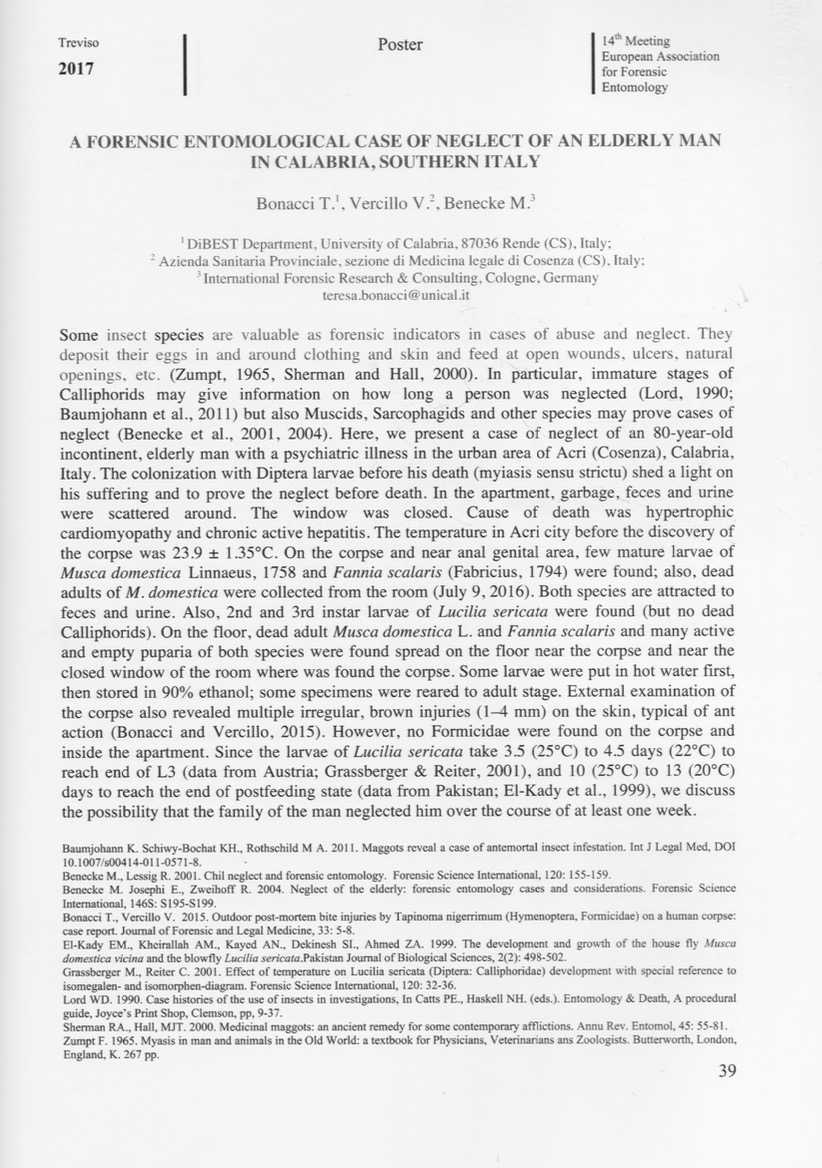2017 06 AAFE Treviso: Difference between revisions
No edit summary |
No edit summary |
||
| Line 76: | Line 76: | ||
* [[Benecke Six Forensic Entomology Cases|Six Forensic Entomology Cases]]<br> | * [[Benecke Six Forensic Entomology Cases|Six Forensic Entomology Cases]]<br> | ||
* [[2018-09-25 Entomofauna on buried carrions in Calabria, Southern Italy (Speech)|Entomofauna on buried carrions in Calabria, Southern Italy]] (Speech) | |||
* [https://www.researchgate.net/publication/11883616_Child_neglect_and_forensic_entomology <font color=lightgrey>Child neglect and forensic entomology</font>]<br> | * [https://www.researchgate.net/publication/11883616_Child_neglect_and_forensic_entomology <font color=lightgrey>Child neglect and forensic entomology</font>]<br> | ||
Revision as of 12:13, 26 October 2018
Source: 14th Meeting European Association for Forensic Entomology, Treviso (I), 7-10. June 2017, Poster and Abstract Volume. Page 39
A Forensic Entomological case of neglect of an elderly man in Calabria, Southern Italy
14th Meeting European Association for Forensic Entomology, Treviso (I), 7-10.06.2017
[Articles from MB] [Articles about MB]
BONACCI, T., VERCILLO, V., BENECKE, M.
Introduction
Some insects species are valuable as forensic indicators in cases of abuse and neglect. They deposit their eggs in and around clothing and skin and feed at open wounds, ulcers, natural openings, etc. (Zumpt, 1965, Sherman and Hall, 2000). In particular, immature stages of Calliphorids may give information on how long a person was neglected (Lord, 1990; Baumjohann et al., 2011) but also Muscids, Sarcophagids and other species may prove cases of neglect (Benecke et al., 2001, 2004).
Here, we present a case of neglect of an 80-year-old incontinent, elderly man with a psychiatric illness in the urban area of Acri (Cosenza), Calabria, Italy. The colonization with Diptera larvae before his death (myiasis sensu strictu) shed a light on his suffering and to prove the neglect before death.
Findings
In the apartment, garbage, feces and urine were scattered around. The window was closed. Cause of death was hypertrophic cardiomyopathy and chronic active hepatitis. The temperature in Acri city before the discovery of the corpse was 23.9 ± 1,35°C.
On the corpse and near anal genital area, few mature larvae of Musca domestica Linnaeus, 1758 and Fannia scalaris (Fabricius, 1794) were found; also, dead adults of M. domestica were collected from the room (July 9, 2016). Both species are attracted to feces and urine. Also, 2nd and 3rd instar larvae of Lucilia sericata were found (but no dead Calliphorids). On the floor, dead adult Musca domestica L. and Fannia scalaris and many active and empty puparia of both species were found spread on the floor near the corpse and near the closed window of the room where was found the corpse. Some larvae were put in hot water first, then stored in 90% ethanol; some specimens were reared to adult stage.
External examination of the corpse also revealed multiple irregular, brown injuries (1–4 mm) on the skin, typical of ant action (Bonacci and Vercillo, 2015). However, no Formicidae were found on the corpse and inside the apartment.
Since the larvae of Lucilia sericata take 3.5 (25°C) to 4.5 days (22°C) to reach end of L3 (data from Austria; Grassberger & Reiter, 2001), and 10 (25°C) to 13 (20°C) days to reach end of postfeeding state (data from Pakistan; El-Kady et al., 1999), we discuss the possibility that the family of the man neglected him over the course of at least one week.
References
- Baumjohann K., & Schiwy-Bochat KH., Rothschild M A. 2011. Maggots reveal a case of antemortal insect infestation. Int J Legal Med, DOI 10.1007/s00414-011-0571-8.
- Benecke M. and Lessig R. 2001. Child neglect and forensic entomology. Forensic Science International, 120: 155-159.
- Benecke M. Josephi E., Zweihoff R. 2004. Neglect of the elderly: forensic entomology cases and considerations. Forensic Science International, 146S: S195-S199.
- Bonacci T. and Vercillo V. 2015. Outdoor post-mortem bite injuries by Tapinoma nigerrimum (Hymenoptera, Formicidae) on a human corpse: case report. Journal of Forensic and Legal Medicine, 33: 5-8.
- El-Kady EM., Kheirallah AM., Kayed AN., Dekinesh SI., Ahmed ZA. 1999. The development and growth of the house fly Musca domestica vicina and the blowfly Lucilia sericata.Pakistan Journal of Biological Sciences, 2(2): 498-502.
- Grassberger M., Reiter C. 2001. Effect of temperature on Lucilia sericata (Diptera: Calliphoridae) development with special reference to isomegalen- and isomorphen-diagram. Forensic Science International, 120: 32-36.
- Lord WD. 1990. Case histories of the use of insects in investigations, In Catts PE., Haskell NH. (eds.). Entomology & Death, A procedural guide, Joyce’s Print Shop, Clemson, pp, 9-37.
- Sherman RA., and Hall, MJT. 2000. Medicinal maggots: an ancient remedy for some contemporary afflictions. Annu Rev. Entomol, 45: 55-81.
- Zumpt F. 1965. Myasis in man and animals in the Old World: a textbook for Physicians, Veterinarians ans Zoologists. Butterworth, London, England, K. 267 pp.
suggested readings
- Ill Simposio Latinoamericano De Entomologia Forense. Medellin, Kolumbien, 31.10 - 3.11.2008 GERMAN TEXT
- Insekten auf Leichen in Kolumbien GERMAN TEXT

